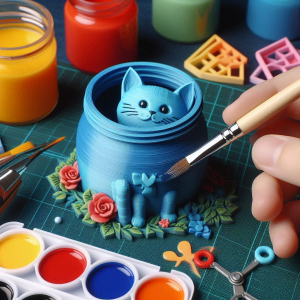seo
Can You Use Acrylic Paint on 3D Printed Objects?

Can You Use Acrylic Paint on 3D Printed Objects?
3D printing has revolutionized how we create and design objects, allowing anyone to bring digital models to life in three-dimensional forms. But what if you want to add color and personality to your 3D-printed items? One of the most common questions that arises is: “Can you use acrylic paint on 3D printed objects?“ The answer is a resounding yes! Acrylic paint is a versatile and user-friendly option for painting 3D-printed objects. In this blog, we’ll explore why acrylic paint is a great choice, how to prepare your 3D prints for painting, and tips for getting the best results.
Why Use Acrylic Paint on 3D Printed Objects?
Can you use acrylic paint on 3D printed objects? The answer is yes, and here’s why acrylic paint is a popular choice for this purpose:
-
Versatility:
Acrylic paint can adhere well to various 3D printing materials, including PLA, ABS, and resin.
-
Vibrant Colors:
Acrylics are known for their bright and vivid colors, which can bring your 3D prints to life.
-
Quick Drying:
Acrylic paint dries quickly, allowing you to layer colors and finish your project faster.
-
Easy to Use:
Whether you are a beginner or a seasoned artist, acrylic paint is easy to work with and requires minimal preparation.
-
Water-Based:
Being water-based, acrylics are non-toxic and easy to clean up with water.
Preparing Your 3D Printed Object for Painting
Before applying acrylic paint, it’s important to prepare your 3D printed object properly. Here’s a step-by-step guide to get your object ready for painting:
-
Clean the Surface
- After printing, your 3D object may have some residue, oils, or dust on the surface. Use a mild soap and water solution to gently clean the object. Rinse thoroughly and let it dry completely.
-
Sand the Surface
- 3D prints often have layer lines and rough spots. Use sandpaper (starting with 120 grit and moving up to 220 grit) to smooth the surface. This will help the paint adhere better and result in a more professional finish.
-
Apply a Primer
- Applying a primer is essential before painting. A primer creates a smooth, even surface for the paint to adhere to and prevents the paint from peeling or flaking. Spray-on primers work well for 3D printed objects. Apply a thin coat, let it dry, and lightly sand the surface for a smoother finish.
-
Select the Right Acrylic Paint
- Choose high-quality acrylic paint for the best results. There are various types of acrylic paints available—such as basic craft acrylics, heavy body acrylics, and fluid acrylics—each offering different consistencies and finishes.
Step-by-Step Guide to Painting 3D Printed Objects with Acrylic Paint
Now that your 3D printed object is prepped and ready, let’s dive into the painting process:
-
Start with a Base Coat
- Apply a base coat to cover the entire surface of the object. This will help create a uniform look and enhance the vibrancy of the colors you apply next. Use a wide brush for larger areas and a smaller brush for intricate details. Allow the base coat to dry completely before proceeding.
-
Build Up Layers of Color
- Acrylic paint works best when applied in thin layers. Start with lighter colors and gradually build up to darker shades. This layering technique adds depth and dimension to the object. Let each layer dry before applying the next to avoid smudging or mixing colors unintentionally.
-
Add Details and Highlights
- Use a fine brush to add details, highlights, and shading to your 3D printed object. This step is where you can get creative and make your object truly unique. You can also use techniques like dry brushing to add texture and visual interest.
-
Seal the Painted Surface
- After you are satisfied with the paint job, it’s crucial to seal the surface to protect the paint from chipping and fading. Use a clear acrylic sealer, which comes in matte, satin, or gloss finishes. Apply a few thin coats, allowing each coat to dry thoroughly.
Tips for Using Acrylic Paint on 3D Printed Objects
-
Choose the Right Brushes:
Use a variety of brush sizes to handle different areas and details. Soft brushes are great for smooth applications, while stiffer brushes are ideal for textures.
-
Use a Palette Knife:
For creating textured effects, consider using a palette knife instead of a brush. This can give your 3D printed object a unique and artistic look.
-
Practice on a Test Print:
If you are new to painting 3D printed objects, practice on a test
print or a small piece first to get a feel for the paint and brushes.
-
Work in a Well-Ventilated Area:
Although it is non-toxic, it’s still best to work in a well-ventilated area, especially when applying primers or sealers.
-
Experiment with Techniques:
Don’t be afraid to experiment with techniques like dry brushing, washing, and glazing to add depth and realism to your painted object.
Can Acrylic Paint Adhere to All 3D Printing Materials?
While it is versatile, its adhesion can vary depending on the 3D printing material:
-
PLA (Polylactic Acid): Can you use acrylic paint on 3D printed objects
made from PLA? Yes, acrylic paint adheres very well to PLA, making it an excellent choice for painting PLA-based 3D prints.
-
ABS (Acrylonitrile Butadiene Styrene):
ABS requires proper sanding and priming, but once prepared, acrylic paint adheres well to it.
-
Resin Prints:
Acrylic paint works beautifully on resin prints due to their smooth and detailed surfaces, but priming is essential.
Conclusion
Acrylic paint is a fantastic choice for bringing your 3D printed objects to life. Its versatility, vibrant colors, and ease of use make it a favorite among hobbyists and artists alike. By following the preparation and painting steps outlined in this guide, you can achieve professional-looking results at home. So grab your brushes and paints, and start transforming your 3D prints today!
Call-to-Action
Looking for more tips on how to customize your 3D prints? Subscribe to our newsletter for the latest guides, tutorials, and inspiration!
